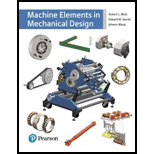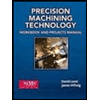
Machine Elements in Mechanical Design (6th Edition) (What's New in Trades & Technology)
6th Edition
ISBN: 9780134441184
Author: Robert L. Mott, Edward M. Vavrek, Jyhwen Wang
Publisher: PEARSON
expand_more
expand_more
format_list_bulleted
Textbook Question
Chapter 2, Problem 14P
For Problems 14 −17, describe what is wrong with each statement.
14. “After annealing, the steel bracket had a Brinell hardness of 750.”
Expert Solution & Answer
Want to see the full answer?
Check out a sample textbook solution
Students have asked these similar questions
Tutorial Problem 3
The following data are obtained from the Charpy impact test of a copper specimen.
a) Length of the square cross-section specimen = 70 mm
b) Each side (top & bottom) of the cross-section = 9.64 mm
c) V – Notch thickness at middle of the specimen length = 1.06 mm
d) Impact Strength = 279 kJ/m²
Determine the Cross-sectional area at the top surface, Cross-sectional area at notch & Impact energy of the
copper specimen.
Problems
1. A Rockwell hardness measurement is made on a ductile iron (80-55-06 as cast) and the
obtained Rockwell hardness R scale is 13 HRC. Predict the tensile and yield strengths of this
material.
2. A Brinell hardness measurement is made on a ductile iron (120-90-02, Oil-quenched) using a
10-mm-diameter sphere of tungsten carbide. A load of 3,000 kg produces a 3.52-mm-
diameter impression in the iron surface.
a. Calculate the BHN of this alloy. (The correct units for the Brinell equation are
kilograms for load and millimeters for diameters.)
b. Predict the tensile and yield strengths
3. Suppose that a ductile iron (100-70-03, air-quenched) has a tensile strength of 800 MPa.
What diameter impression would you expect the 3,000-kg load to produce with the 10-mm-
diameter ball?
Search
LO
W
SE
Draw a Stress/Strain graph of a mild tensile steel and identify the limit of proportionality and the yield point
Chapter 2 Solutions
Machine Elements in Mechanical Design (6th Edition) (What's New in Trades & Technology)
Ch. 2 - Define ultimate tensile strength.Ch. 2 - Define yield point.Ch. 2 - Define yield strength and tell how it is measured.Ch. 2 - What types of materials would have a yield point?Ch. 2 - What is the difference between proportional limit...Ch. 2 - Define Hooke’s law.Ch. 2 - What property of a material is a measure of its...Ch. 2 - What property of a material is a measure of its...Ch. 2 - If a material is reported to have a percent...Ch. 2 - Define Poisson’s ratio.
Ch. 2 - If a material has a tensile modulus of elasticity...Ch. 2 - A material is reported to have a Brinell hardness...Ch. 2 - A steel is reported to have a Brinell hardness of...Ch. 2 - For Problems 14 17, describe what is wrong with...Ch. 2 - For Problems 14 17, describe what is wrong with...Ch. 2 - For Problems 14 17, describe what is wrong with...Ch. 2 - For Problems 14 17, describe what is wrong with...Ch. 2 - Name two tests used to measure impact energy.Ch. 2 - Prob. 19PCh. 2 - Prob. 20PCh. 2 - Prob. 21PCh. 2 - What is the typical carbon content of a low-carbon...Ch. 2 - How much carbon does a bearing steel typically...Ch. 2 - What is the main difference between SAE 1213 steel...Ch. 2 - Name four materials that are commonly used for...Ch. 2 - Name four materials that are typically used for...Ch. 2 - Describe the properties desirable for the auger...Ch. 2 - Prob. 28PCh. 2 - Appendix 3If a shovel blade is made from SAE 1040...Ch. 2 - Describe the differences between through-hardening...Ch. 2 - Describe the process of induction hardening.Ch. 2 - Prob. 32PCh. 2 - Prob. 33PCh. 2 - Prob. 34PCh. 2 - Prob. 35PCh. 2 - Prob. 36PCh. 2 - Name three types of cast iron.Ch. 2 - Prob. 38PCh. 2 - Describe the process of making parts from powdered...Ch. 2 - Prob. 40PCh. 2 - Prob. 41PCh. 2 - Prob. 42PCh. 2 - Prob. 43PCh. 2 - Prob. 44PCh. 2 - Prob. 45PCh. 2 - Prob. 46PCh. 2 - Name three typical uses for titanium alloys.Ch. 2 - Prob. 48PCh. 2 - Prob. 49PCh. 2 - Prob. 50PCh. 2 - Describe the difference between thermosetting...Ch. 2 - Suggest a suitable plastic material for each of...Ch. 2 - Name eight factors over which the designer has...Ch. 2 - Define the term composite.Ch. 2 - Prob. 55PCh. 2 - Name four types of reinforcement fibers used for...Ch. 2 - Prob. 57PCh. 2 - Prob. 58PCh. 2 - Prob. 59PCh. 2 - For what applications are sheet-molding compounds...Ch. 2 - Prob. 61PCh. 2 - Prob. 62PCh. 2 - Prob. 63PCh. 2 - Prob. 64PCh. 2 - Prob. 65PCh. 2 - Prob. 66PCh. 2 - Prob. 67PCh. 2 - Prob. 68PCh. 2 - Discuss the advantages of composite materials...Ch. 2 - Prob. 70PCh. 2 - Prob. 71PCh. 2 - Prob. 72PCh. 2 - Prob. 73PCh. 2 - Describe the general construction of a composite...Ch. 2 - Prob. 75PCh. 2 - Prob. 76PCh. 2 - Prob. 77PCh. 2 - Prob. 78PCh. 2 - Prob. 79PCh. 2 - Prob. 80PCh. 2 - Prob. 81PCh. 2 - Prob. 82PCh. 2 - Prob. 83PCh. 2 - Problems 8290. For composites made with the given...Ch. 2 - Prob. 85PCh. 2 - Prob. 86PCh. 2 - Prob. 87PCh. 2 - Prob. 88PCh. 2 - Prob. 89PCh. 2 - Prob. 90PCh. 2 - Prob. 91PCh. 2 - Prob. 92PCh. 2 - Prob. 93PCh. 2 - Problems 94 96. For the given specification for a...Ch. 2 - Prob. 95PCh. 2 - Prob. 96PCh. 2 - Prob. 97PCh. 2 - Prob. 98PCh. 2 - Prob. 99PCh. 2 - Describe how CNTs are used in a CMNC and what...Ch. 2 - Prob. 1SPCh. 2 - Prob. 2SPCh. 2 - Prob. 3SPCh. 2 - Prob. 4SPCh. 2 - Prob. 5SPCh. 2 - Prob. 6SPCh. 2 - Name three U.S. organizations whose names are...Ch. 2 - Prob. 8SPCh. 2 - A U.S. designer specifies SAE 4140 steel for a...Ch. 2 - Prob. 10SPCh. 2 - Prob. 11SPCh. 2 - Prob. 12SPCh. 2 - Prob. 13SPCh. 2 - Prob. 14SPCh. 2 - Prob. 15SPCh. 2 - Prob. 16SPCh. 2 - Prob. 17SPCh. 2 - Prob. 18SPCh. 2 - Prob. 19SPCh. 2 - Prob. 20SPCh. 2 - Prob. 21SPCh. 2 - Prob. 22SPCh. 2 - Prob. 23SPCh. 2 - Prob. 24SPCh. 2 - Prob. 25SPCh. 2 - Prob. 26SPCh. 2 - Prob. 27SPCh. 2 - Prob. 28SPCh. 2 - Prob. 29SPCh. 2 - Prob. 30SPCh. 2 - Prob. 31SPCh. 2 - Prob. 32SPCh. 2 - Prob. 33SPCh. 2 - Prob. 34SPCh. 2 - List the six general classifications of materials...Ch. 2 - Prob. 36SPCh. 2 - Prob. 37SPCh. 2 - Prob. 38SPCh. 2 - Prob. 39SPCh. 2 - Prob. 40SP
Knowledge Booster
Learn more about
Need a deep-dive on the concept behind this application? Look no further. Learn more about this topic, mechanical-engineering and related others by exploring similar questions and additional content below.Similar questions
- 3000 kg, 10mm Steel Ball Brinell Hardness Reading of 421 is equal to what Rockwell C Reading?arrow_forward12. What are is an impact tests. Sketch the impact testing machine setup and explain the basic principle of toughness determination from it. What is DBTT? sketch the impact energy vs temperature curve for plain carbon steel and discuss why do many materials become brittle at low temperatures.arrow_forwardSubcritical annealing can be done at lower temperature than full annealing. Select one: True Falsearrow_forward
- Subcritical annealing can be done at higher temperature than full annealing. Select one: True Falsearrow_forwardTag question Consider the graph below for 3 metals which have been cold-worked. From the graphs, which of the following statements are true? Stress Select one or more: a. C. Strain & A e. B C b. B and C have similar hardness; C has greater brittleness B is softer than C and has nearly similar ductility A is harder than C and is more ductile d. A and B have similar hardness; A has greater brittleness A is harder than C and is less ductile f. B is harder than C but has nearly similar ductility 5 up i A Carrow_forwardAn application requires ultimate tensile strength and yield strength ofa steel at 110 ksi and 91 ksi, respectively. Answer the following 4 questions:4.1. Can SAE 1040 steel be selected for this application?4.2. If “no” is the answer in Part I, the following Part II, III, and IV can beignored. If “yes” is the answer in Part I, which condition of SAE 1040 shouldbe selected?4.3. Why is that steel with the condition in part II selected?4.4. Is the selected steel brittle or ductile? and Why?arrow_forward
- 4) Draw a stress-strain curve for a low carbon steel and explain important points and regions in detail. What fracture behavior does this steel exhibit?arrow_forwardAn application requires ultimate tensile strength and yield strength ofa steel at 110 ksi and 91 ksi, respectively. Answer the following 4 questions: Can SAE 1040 steel be selected for this application? If “no” is the answer in Part I, the following Part II, III, and IV can beignored. If “yes” is the answer in Part I, which condition of SAE 1040 shouldbe selected? Why is that steel with the condition in part II selected? Is the selected steel brittle or ductile? and Why?arrow_forward1- With the Vickers hardness test a 10 kg load gave for a sample of brass an indentation with diagonals having mean lengths of 0.510 mm. What is the hardness? Again, what is tensile strength of brass? 2- When a load is applied to a brass specimen in a Brinell test, an indentation of 4.10 mm is Ahimary produced. Estimate the tensile strength of the brass.arrow_forward
- Direct hardening can be performed on steel containing at least________ carbon.arrow_forwardA 2.0-inch diameter 4140 steel bar is austenized and tempered in oil without Agitation, determine the resulting hardness at 0.6 inches below the surface, present all the Procedure to arrive at the answer (include sketch of the piece and graph used with steps Using word forms)arrow_forwardMention the main advantage of Vickers hardness test method?arrow_forward
arrow_back_ios
SEE MORE QUESTIONS
arrow_forward_ios
Recommended textbooks for you
 Precision Machining Technology (MindTap Course Li...Mechanical EngineeringISBN:9781285444543Author:Peter J. Hoffman, Eric S. Hopewell, Brian JanesPublisher:Cengage Learning
Precision Machining Technology (MindTap Course Li...Mechanical EngineeringISBN:9781285444543Author:Peter J. Hoffman, Eric S. Hopewell, Brian JanesPublisher:Cengage Learning

Precision Machining Technology (MindTap Course Li...
Mechanical Engineering
ISBN:9781285444543
Author:Peter J. Hoffman, Eric S. Hopewell, Brian Janes
Publisher:Cengage Learning
Introduction to Ferrous and Non-Ferrous Metals.; Author: Vincent Ryan;https://www.youtube.com/watch?v=zwnblxXyERE;License: Standard Youtube License